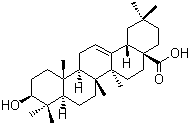| Product Name: | Oleanic acid | |
| Product Type: | Pure Plant Extracts | ||
| Usage: | have hepatoprotective, antiinflammatory, and antihyperlipidemic properties.have been used in cosmetics and health products. | ||
| Clicks: | 2741 | ||
| Release Time: | 2010-05-19 | ||
| Introduction | |||
Name : Oleanic acid Synonyms : Oleanolic acid; 3beta-Hydroxyolean-12-en-28-oic acid Molecular Structure : Molecular Formula : C30H48O3 Molecular Weight: 456.71 CAS Registry Number: 508-02-1 EINECS :208-081-6 Melting point : >300 ºC Oleanolic acid is a triterpenoid compound that is widespread in nature, in particular it occurs in leaves of Olea europea L. (Oleaceae). It has been long recognized to have hepatoprotective, antiinflammatory, and antihyperlipidemic properties. Recently oleanolic acid has been noted for its antitumor-promotion effect. Little is known about the antiviral activity of this compound. In this study the effect of oleanolic acid on the growth of HIV-1 in cultures of human peripheral blood mononuclear cells (PBMC) was investigated Both oleanolic acid and ursolic acid are effective in protecting against chemically induced liver injury in laboratory animals. Oleanolic acid has been marketed in China as an oral drug for human liver disorders. The mechanism of hepatoprotection by these two compounds may involve the inhibition of toxicant activation and the enhancement of the body defense systems. Oleanolic acid and ursolic acid have also been long-recognized to have antiinflammatory and antihyperlipidemic properties in laboratory animals, and more research is warranted to develop a therapy for patients. Recently, both compounds have been noted for their antitumor-promotion effects, which are stimulating additional research in this field. Oleanolic acid and ursolic acid are relatively non-toxic, and have been used in cosmetics and health products. The possible mechanisms for the pharmacological effects and the prospects for these two compounds are discussed.
Packing Detail:
| |||







 Oleanic acid
Oleanic acid 
